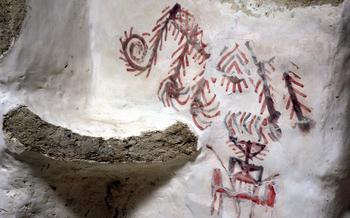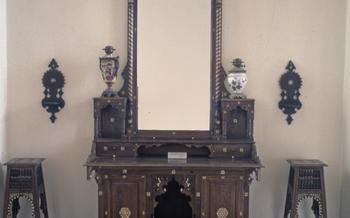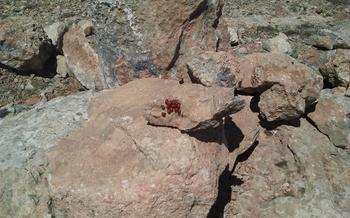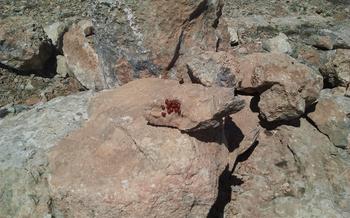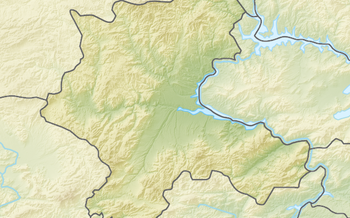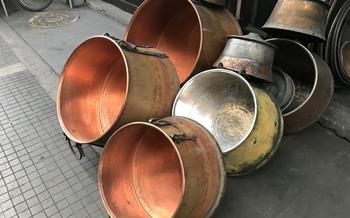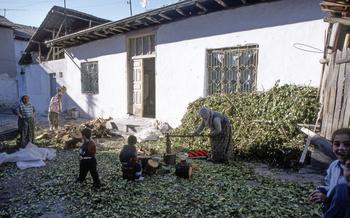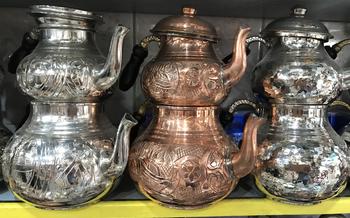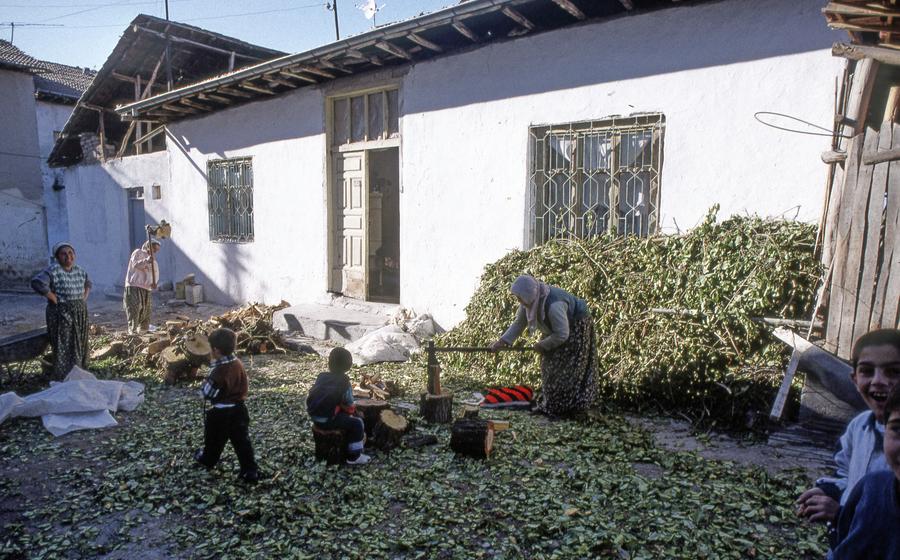
Savaklı Village Rock Tombs
- History of the Savaklı Village Rock Tombs
- Location and Accessibility:
- Architectural Features
- Historical Significance
- Types of Tombs
- Carvings and Decorations
- Burials and Funerary Practices
- Archaeological Excavations
- Cultural Importance
- Visiting the Savaklı Village Rock Tombs
- Guided Tours
- Photography and Videography
- Accommodation and Dining
- Combining with Other Attractions
- Insider Tip
History of the Savaklı Village Rock Tombs
The Savaklı Village Rock Tombs, located in the picturesque village of Savaklı in Malatya, Turkey, stand as testaments to the region's rich cultural heritage and ancient civilizations. These remarkable tombs, carved into the rocky cliffs that surround the village, date back to the 4th century BC, a period of significant historical and cultural transformation in Anatolia. The tombs were meticulously crafted by skilled artisans and served as final resting places for important figures in the local community.
The construction of these rock tombs was influenced by various factors, including religious beliefs, cultural practices, and the geographic landscape of the region. The ancient inhabitants of Savaklı believed in an afterlife and viewed the tombs as sacred spaces where the deceased could transition to the next realm. The tombs also held significant cultural value, symbolizing the prestige and status of the individuals buried within.
The architectural style of the Savaklı Village Rock Tombs is characterized by its unique blend of functionality and aesthetics. The tombs feature a variety of designs, ranging from simple rectangular chambers to more elaborate structures with intricate facades and decorative elements. The tombs were often adorned with carvings, inscriptions, and reliefs depicting various motifs and symbols, providing valuable insights into the beliefs and artistic traditions of the ancient society.
Location and Accessibility:
The Savaklı Village Rock Tombs are nestled in the picturesque village of Savaklı, situated approximately 25 kilometers southwest of Malatya city center. This ancient site is easily accessible by various means of transportation, making it a convenient destination for history and culture enthusiasts.
If you're traveling by car, follow the D-300 highway towards Savaklı village. Once you reach the village, look for signs that will guide you to the tomb site, which is located on the outskirts of the village. Alternatively, you can opt for a leisurely bus ride from Malatya city center to Savaklı village, enjoying the scenic countryside views along the way.
For a more immersive experience, consider joining an organized tour or excursion that includes a visit to the Savaklı Village Rock Tombs. These tours often provide transportation, guided commentary, and additional insights into the history and significance of the site.
If you prefer self-guided exploration, make sure to arrive early to avoid crowds and have ample time to explore the tombs at your own pace. The site is open to the public year-round, with entrance fees that are minimal and contribute to the preservation and maintenance of this historical treasure.
Architectural Features
The Savaklı Village Rock Tombs stand out for their exceptional rock-cut architecture, showcasing the advanced engineering and artistic skills of the ancient craftsmen. These tombs are carved directly into the rocky cliffs, creating a unique and awe-inspiring sight. The site features various types of tombs, each with distinct architectural styles and designs.
The most common type is the single-chamber tomb, consisting of a single room carved into the rock. These tombs often have a simple rectangular shape with a flat roof. Some single-chamber tombs feature niches or shelves where grave goods and offerings were placed.
Another type of tomb found at Savaklı is the multi-chamber tomb. These tombs comprise multiple chambers connected by narrow passages or doorways. The chambers may vary in size and shape, with some featuring intricate carvings and decorations. Multi-chamber tombs were likely used for more prominent individuals or families.
The facades of the tombs are adorned with intricate carvings and decorations, showcasing the artistic prowess of the ancient craftsmen. These carvings depict various motifs and symbols, including geometric patterns, floral designs, and human figures. The carvings provide valuable insights into the beliefs, culture, and artistic traditions of the ancient society.
The architectural features of the Savaklı Village Rock Tombs not only serve as stunning examples of ancient craftsmanship but also provide valuable clues about the social structure, religious beliefs, and cultural practices of the people who created them.
Historical Significance
The Savaklı Village Rock Tombs stand as a testament to the rich history and heritage of the Malatya region. These ancient burial chambers offer a glimpse into the lives and beliefs of past civilizations. The tombs have been instrumental in shedding light on the cultural practices and social structures of the ancient society that inhabited this area.
The tombs' connection to other historical sites in Malatya further enhances their significance. They are part of a network of archaeological sites that provide a comprehensive understanding of the region's history and cultural evolution. Ongoing archaeological research and discoveries at the site continue to contribute to our knowledge of this fascinating period.
Types of Tombs
The Savaklı Village Rock Tombs encompass a diverse range of tomb types, each with its own distinct characteristics and features. These tombs can be broadly categorized into three main types:
-
Chamber Tombs: These are the most common type of tomb found at the site. They consist of a single chamber carved into the rock face, with a rectangular or square floor plan. The chambers typically feature a raised platform or bench along one or more walls, where the deceased were laid to rest.
-
Multiple-Chamber Tombs: These tombs are more elaborate and consist of multiple chambers connected by narrow passages or doorways. The chambers may vary in size and shape, and some may include additional features such as niches, alcoves, or benches.
-
Temple Tombs: These are the most elaborate and impressive tombs at the site. They feature a temple-like facade with columns, pediments, and decorative elements. The interiors of these tombs are often divided into multiple chambers, including a main chamber where the deceased was laid to rest and smaller chambers for offerings and rituals.
The variety of tomb types at the Savaklı Village Rock Tombs reflects the social stratification and cultural diversity of the ancient society that built them. The more elaborate tombs were likely reserved for individuals of higher status or wealth, while the simpler tombs were used for the common people.
Carvings and Decorations
The Savaklı Village Rock Tombs are adorned with intricate carvings and decorations that offer valuable insights into the beliefs and culture of the ancient society that created them. These carvings depict a variety of motifs and symbols, ranging from geometric patterns to floral designs, human figures, and animals. The techniques used to create these carvings demonstrate a high level of craftsmanship and artistic skill.
One of the most striking features of the carvings is their depiction of human faces. These faces, often carved in relief, display a wide range of emotions and expressions, from serene to somber. Some of the faces appear to be portraits of individuals, while others may represent deities or mythological figures.
The floral and geometric patterns found on the tombs are equally impressive. These intricate designs often cover the entire facade of the tomb, creating a visually stunning effect. The flowers and plants depicted in these carvings may have had symbolic meanings, representing the cycle of life and death or the journey of the soul to the afterlife.
The animals depicted in the carvings also hold symbolic significance. Lions, for example, were often associated with strength and courage, while bulls were symbols of fertility and virility. The presence of these animals on the tombs suggests that the ancient people of Savaklı Village believed in the power of these creatures to protect and guide the deceased in the afterlife.
By studying the carvings and decorations on the Savaklı Village Rock Tombs, archaeologists and historians are able to gain a deeper understanding of the beliefs, customs, and artistic traditions of the ancient society that created them. These carvings provide a glimpse into the minds and hearts of a people long gone, offering a tangible connection to their culture and heritage.
Burials and Funerary Practices
The Savaklı Village Rock Tombs offer a glimpse into the ancient burial practices and funerary rituals of the region. Archaeological excavations have revealed a wealth of information about the beliefs and customs surrounding death and afterlife.
Burials at the site were typically conducted in individual rock-cut chambers. Each chamber contained a single burial, often accompanied by grave goods such as jewelry, pottery, and tools. The bodies were laid to rest in a supine position, with their heads oriented towards the east.
The tombs also provide evidence of elaborate burial rituals. Offerings of food and drink were placed in the chambers, along with personal belongings that were believed to accompany the deceased in the afterlife. In some cases, the walls of the chambers were decorated with paintings or carvings depicting scenes from the deceased's life or religious beliefs.
The discovery of these burial practices and rituals highlights the significance of the Savaklı Village Rock Tombs as a testament to the rich cultural and religious heritage of the ancient society that created them. These tombs offer a unique window into the beliefs and customs surrounding death and afterlife in this fascinating region.
Archaeological Excavations
The Savaklı Village Rock Tombs have been the subject of extensive archaeological excavations since their discovery. The first excavations were conducted in the early 1900s by Turkish archaeologists, who uncovered a number of tombs and artifacts. In the 1970s, a team of international archaeologists from various institutions, including the University of Chicago and the Turkish Ministry of Culture, conducted a more comprehensive excavation of the site. This team uncovered a large number of additional tombs and artifacts, including pottery, jewelry, and weapons.
The excavations at the Savaklı Village Rock Tombs have provided valuable insights into the history and culture of the people who buried their dead there. The tombs have been dated to the Roman period, and the artifacts found within them suggest that the people who used them were wealthy and powerful. The excavations have also revealed that the tombs were used for multiple burials, and that the bodies were often accompanied by grave goods. These findings suggest that the people who buried their dead at the Savaklı Village Rock Tombs believed in an afterlife.
The ongoing archaeological research at the Savaklı Village Rock Tombs is helping to shed light on the lives and culture of the people who lived in this region during the Roman period. The excavations are also helping to preserve this important historical site for future generations.
Cultural Importance
The Savaklı Village Rock Tombs hold immense cultural significance, deeply intertwined with the history and heritage of Turkey. These tombs stand as testaments to the region's rich cultural legacy, offering valuable insights into past civilizations and their traditions. As cultural treasures, they play a crucial role in promoting tourism and preserving local identity. Initiatives to raise awareness and protect the cultural value of the site ensure that its significance is not only preserved but also shared with future generations. These efforts contribute to the broader understanding and appreciation of Turkey's diverse cultural heritage, fostering a sense of pride and connection among its people.
Visiting the Savaklı Village Rock Tombs
To explore the fascinating Savaklı Village Rock Tombs, visitors are welcome during specific visiting hours. The site is open to the public, and a nominal entrance fee is required. It's advisable to allocate at least half a day for your visit to fully appreciate the grandeur of the tombs and the surrounding landscape. To make the most of your experience, consider visiting during the shoulder seasons (spring or fall) when the weather is pleasant, and there are fewer crowds.
The Savaklı Village Rock Tombs offer basic amenities for visitors, including parking areas and restrooms. While exploring the site, remember to wear comfortable shoes suitable for walking on uneven terrain. Sunscreen, hats, and sunglasses are recommended for protection against the sun, especially during the summer months.
Guided Tours
Exploring the Savaklı Village Rock Tombs with a knowledgeable guide can greatly enhance your experience. Guided tours offer a deeper understanding of the tombs' history, cultural significance, and architectural features. Professional guides are well-versed in the site's history and can provide fascinating insights and anecdotes that bring the tombs to life. They can point out intricate details and carvings that you might otherwise miss, helping you appreciate the site's unique features.
Various tour options are available, catering to different interests and preferences. General guided tours provide an overview of the tombs' history and significance, while specialized tours may focus on specific aspects such as architecture, carvings, or burial practices. Group tours are a great way to share the experience with fellow travelers, while private tours offer a more personalized experience with the guide's undivided attention.
To book a guided tour, you can contact local tour operators or inquire at the site's visitor center. Prices vary depending on the type of tour and the number of participants. Be sure to book in advance, especially during peak tourist season, to secure your spot.
During the tour, feel free to ask questions and engage with your guide. They are there to make your visit as informative and enjoyable as possible. Remember to follow the guide's instructions and stay within designated areas to ensure the preservation of this valuable heritage site.
Photography and Videography
Guidelines for Responsible Documentation:
Visitors to the Savaklı Village Rock Tombs are welcome to capture the beauty and significance of the site through photography and videography. However, it is important to adhere to certain guidelines to ensure the preservation of the tombs and the respect of other visitors.
-
Flash Photography Prohibited: The use of flash photography is prohibited inside the tombs to prevent damage to the delicate carvings and paintings. Natural light or artificial lighting provided at the site should be sufficient for capturing images.
-
Tripods and Equipment: Visitors are allowed to bring tripods and other photography equipment, but they should be mindful of their placement and avoid obstructing walkways or disturbing other visitors.
-
Respecting Privacy: When photographing or filming, it is important to be respectful of other visitors and avoid capturing them in your shots without their consent.
-
Drones and Other Equipment: The use of drones and other flying equipment is generally not permitted at the site to ensure the safety of visitors and the preservation of the tombs.
-
Commercial Photography: Commercial photography or videography for commercial purposes requires prior permission from the relevant authorities.
By following these guidelines, visitors can contribute to the preservation of the Savaklı Village Rock Tombs while capturing their own unique memories of this extraordinary site.
Accommodation and Dining
When visiting the Savaklı Village Rock Tombs, you will find several accommodation options to suit different budgets and preferences. For those seeking a luxurious and comfortable stay, there are upscale hotels in the nearby city of Malatya. These hotels offer modern amenities, spacious rooms, and often have stunning views of the surrounding landscape.
For a more budget-friendly option, there are several guesthouses and hostels in the area. These accommodations provide a comfortable and affordable place to stay, with basic amenities and a friendly atmosphere. Some guesthouses also offer traditional Turkish breakfasts, allowing you to experience the local cuisine.
In terms of dining, there are several restaurants and cafes in the vicinity of the Savaklı Village Rock Tombs. You can savor delicious Turkish cuisine at these establishments, including traditional dishes such as kebabs, pide, and gözleme. Many restaurants offer outdoor seating, allowing you to enjoy your meal while taking in the beautiful surroundings.
When it comes to local cuisine, Malatya is famous for its apricots, which are renowned for their sweet and tangy flavor. Be sure to try apricot-based dishes and desserts, such as apricot jam, apricot cake, and apricot ice cream.
For budget-conscious travelers, there are several options for finding affordable accommodation and dining options. Look for guesthouses that offer dormitory-style rooms or shared apartments. You can also save money by cooking your own meals, as there are several grocery stores in the area where you can buy fresh ingredients.
Combining with Other Attractions
The Savaklı Village Rock Tombs are just one of many fascinating attractions in the Malatya region. Visitors can easily combine their visit to the tombs with other nearby attractions to create a comprehensive itinerary for exploring the region.
Consider visiting the Arslantepe Mound, an ancient city dating back to the 4th millennium BC, renowned for its well-preserved fortifications and stunning sculptures. The Malatya Museum is a treasure trove of artifacts from the region's rich history and culture, including a collection of Hittite hieroglyphs and ancient coins.
Nature enthusiasts can explore the scenic Battalgazi Canyon, with its breathtaking views and opportunities for hiking, camping, and birdwatching. For a spiritual experience, visit the Süleymanlı Mosque, a beautiful example of Seljuk architecture with intricate tilework and calligraphy.
To immerse yourself in the local culture, head to the Malatya Bazaar, where you can browse traditional handicrafts, savor delicious local cuisine, and interact with friendly locals. With so much to offer, the Malatya region promises an unforgettable journey through history, culture, and natural beauty.
Insider Tip
Beyond the remarkable tombs, the village of Savaklı itself holds hidden gems waiting to be discovered. Take a stroll through its charming streets and engage with the friendly locals, who are always eager to share stories and insights into their rich cultural heritage. Immerse yourself in the local traditions by visiting the village's traditional bazaar, where you can find an array of handmade crafts, organic produce, and delicious local delicacies. For a unique experience, join a cooking class and learn to prepare authentic Turkish dishes using fresh, seasonal ingredients. The warmth and hospitality of the Savaklı community will leave you with lasting memories and a deeper appreciation for the region's vibrant culture.
